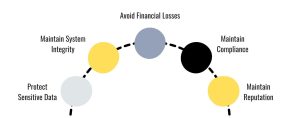Importance of Timely Security Patching in Software Maintenance
Introduction In today’s fast-paced digital world, security threats are constantly evolving. Cybercriminals are constantly looking for new vulnerabilities to exploit. This real...

Introduction
In today’s fast-paced digital world, security threats are constantly evolving. Cybercriminals are constantly looking for new vulnerabilities to exploit. This reality makes timely security patching an essential part of software maintenance. Ignoring or delaying patching can lead to data breaches, financial losses, and reputational damage. Let’s look at why software maintenance is important to keep your software secure with timely security patching and how it benefits both companies and users.
What Is Security Patching?
Security patches are updates released by software developers to fix vulnerabilities. These flaws may have been discovered by the development team or reported by third parties, such as ethical hackers. Once discovered, developers create patches to fix the issues and protect users from potential threats.
However, simply creating these patches is not enough. Timely installation is just as important. The gap between the release of a patch and its application creates a window of opportunity for hackers.

Why Timely Security Patching Matters
1. Protect Sensitive Data
Data is often a company’s most valuable asset. Whether it’s customer information, financial records, or trade secrets, unauthorized access can have serious consequences. Security patches close the doors that hackers can use to access this information.
2. Maintain System Integrity
Without proper security maintenance, software systems become unstable. Vulnerabilities can allow attackers to change system settings, disrupt operations, or inject malicious code. Installing security patches helps maintain a stable and secure working environment.
3. Avoid Financial Losses
Cybersecurity breaches can be costly. The costs associated with troubleshooting, fines, and lost revenue add up quickly. By promptly patching software vulnerabilities, companies can avoid these unnecessary expenses.
4. Maintain Compliance
Many industries have strict data protection and security regulations. Failure to apply security patches in a timely manner can result in non-compliance and significant fines. Regular maintenance helps companies stay on the right side of the law.
5. Maintain Reputation
A company’s reputation can take a serious hit after a data breach. Customers are unlikely to trust companies that have been compromised. Keeping your systems secure with timely patches builds and maintains stakeholder trust.

Challenges of Security Patching
Despite its importance, timely patching is not always easy. Here are some common challenges:
- Resource constraints: Small businesses may have difficulty dedicating the time and staff to regular updates.
- Compatibility issues: Some patches may conflict with other software, causing problems.
- Complex environments: Large companies with extensive IT infrastructures may have a hard time managing patches across multiple systems.
Best Practices for Effective Security Patching
- Automate when possible. Automation tools can help identify and deploy patches quickly. This reduces the burden on IT departments and ensures that patches are applied without delay.
- Maintain an inventory. Keep a detailed list of all software, operating systems, and devices in use. This helps track what needs to be patched and when.
- Test before deployment. While patching in a timely manner is important, testing patches in a controlled environment can prevent compatibility issues.
- Schedule regular maintenance. Create a regular schedule of security updates. This proactive approach ensures that systems are secure without last-minute fuss.
- Monitor and assess. Monitor industry news for new threats and monitor your systems for unusual activity. Regularly assess the effectiveness of the patching process.

Real-Life Consequences of Delayed Patching
A prime example is the 2017 WannaCry ransomware attack. It exploited a known vulnerability in Windows systems, even though Microsoft had already released a patch. Organizations that did not apply the patch suffered massive disruptions and financial losses.
This incident highlights the important role of timely security patching in protecting businesses from preventable threats.
Conclusion
Timely security patching is not just a technical task, it is a fundamental part of protecting your business. With the right strategies and proactive thinking, organizations can protect their systems, maintain customer trust, and stay ahead of cyber threats.
Don’t wait until it’s too late. Protect your software today and build a future where technology serves your business safely and effectively.